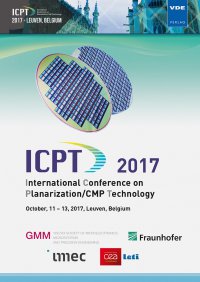In-line Real-time Conductivity Technique for Monitoring of Liquid Chemical Concentration during Semiconductor Manufacturing
Conference: ICPT 2017 - International Conference on Planarization/CMP Technology
10/11/2017 - 10/13/2017 at Leuven, Belgium
Proceedings: ICPT 2017
Pages: 4Language: englishTyp: PDF
Personal VDE Members are entitled to a 10% discount on this title
Authors:
Jie, Hong (School of Mechanical Engineering, Sungkyunkwan University (SKKU), 2066, Seobu-ro, Jangan-gu, Suwon-si, Gyeonggi-do, 16419, Republic of Korea)
Kulkarni, Atul (Symbiosis Centre for Nanoscience and Nanotechnology, Symbiosis International University, Pune, India)
Kim, Hyeong-U; Kim, Taesung (School of Mechanical Engineering, Sungkyunkwan University (SKKU), 2066, Seobu-ro, Jangan-gu, Suwon-si, Gyeonggi-do, 16419, Republic of Korea & SKKU Advanced Institute of Nanotechnology (SAINT), Sungkyunkwan University (SKKU), 2066, Seobu-ro, Jangan-gu, Suwon-si, Gyeonggi-do, 16419, Republic of Korea)
Abstract:
Real-time measurement of liquid concentration is important in chemical mechanical polishing (CMP). It needs precise concentration of chemicals such as post CMP cleaning solutions and metal/oxide etchants. The change of concentration will lead to the decline of product quality. And in order to increase production, it is necessary to improve the matching efficiency and shorten the matching time. All these need to monitor the concentration of liquid in real time and improve the process control requirements. Various technologies are used to monitor chemical concentration such as refractive index, ultrasonic and conductivity. Each has its advantages and disadvantages on cost, measurement range, test condition and etc. The right technology used to monitor concentration of solution must be precise and efficient, yet be cost-effective to implement. In this research, based on the measurement of electricity changes caused by different concentration of Tetramethylammonium hydroxide (TMAH), electrical conductivity technique was used to determine the chemical concentration of TMAH in-line and real-time. The setup includes continuous chemical flow system integrated with conductivity sensor. The supplying AC current was 0.25 mA. As the TMAH concentration increased, the conductivity was found to be increased. This technique was found to be highly sensitive towards TMAH concentration ranging from 0 to 3wt%. Compared with other technologies, this method has the advantage of low-cost and simplicity for detecting low concentration in TMAH. Keywords: Conductivity, Real time, Chemical concentration


